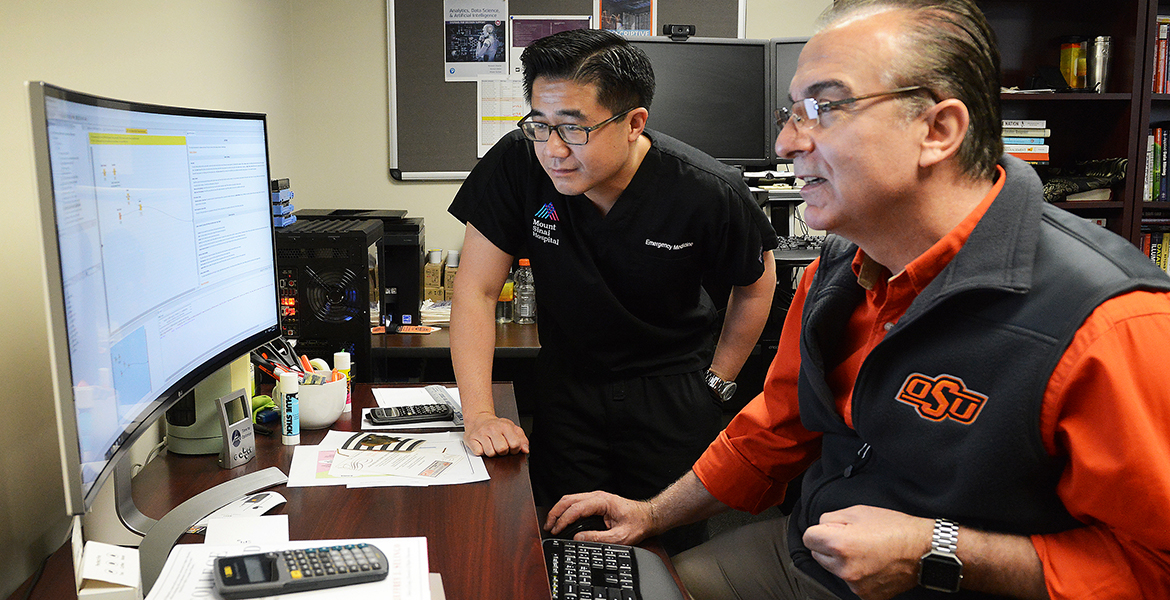
Using data in diagnoses
Wednesday, October 23, 2019
Dursun Delen collaborates on research to improve ER outcomes
A growing problem among hospitals across the country is “bounce back” — patients returning to the ER to be treated a second time for the same condition. Oklahoma State University data science researcher Dr. Dursun Delen collaborated this spring with an emergency room physician to study how artificial intelligence and machine learning can help solve this problem.
Delen, a Regents Professor in Management Science and Information Systems in the Spears School of Business and an OSU-Tulsa faculty member, was chosen from a nationwide field of data research experts to participate in the Data Science Rotation for Advancing Discovery Trip (RoAD-Trip). The National Institutes of Health program pairs junior biomedical researchers with senior data scientists to study translating biomedical data into knowledge to address public health care issues.
As the senior member of the collaboration, Delen mentored Dr. Paul Peng, a physician and biomedical researcher from the Icahn School of Medicine at Mount Sinai in New York City. Peng spent two weeks working with Delen and his former doctoral student Dr. Behrooz Davazdahemami on the Tulsa campus. Peng earned a doctorate from the University of California at Berkeley and attended medical school at the Icahan School of Medicine, where he is completing a residency in emergency medicine.
Delen, who has published more than 100 peer-reviewed data science papers, said the project paired his expertise in machine learning methods with a practicing emergency medicine doctor interested in applied artificial intelligence and deep learning.
“Dr. Peng works as a resident physician in the emergency department at the Mount Sinai Health System in New York City, one of the nation’s top hospitals,” Delen said. “But he’s also very keen on analytics research and realizes the future of medicine is being driven by data. He’s very interested in computers helping doctors make faster and better diagnostic and treatment decisions.”

The pair worked on data modeling to help understand the underlying causes of patients needing to be readmitted, or bounced back, for medical treatment following an emergency room visit, which is leading to a growing number of deaths in U.S. hospitals. The researchers accessed two of the nation’s largest electronic health records databases, OSU’s Center for Health Systems Innovation and the Icahn School of Medicine at Mount Sinai, and used advanced machine learning and deep learning methods to model disease diagnoses in the ER.
“We have patients who come back to the ER after they’re discharged, sometimes within 72 hours, and often we have to go back and study why that happened,” Peng said. “We do that by going back to their medical records to see why they came in the first time and then why they came back. But we have to manually look at what happened. Did we make some mistakes? Did the patient not tell us something? Was there something in their record that we missed? It’s very laborious.”
The researchers looked at ER patient data to see if patterns could be identified using computer models to offer insight into the issue. According to Peng, Mount Sinai hospital has as many as 700 patients readmitted each month to be treated again following a previous ER visit.
“We’re trying to leverage the abilities of computers to pull out representations and patterns from data. That’s what they’re good at,” Peng said. “Computers don’t know the medical context of the data but they’re looking for patterns nonetheless.”
And it’s not just information in databases, known as structured data, that can be analyzed. Peng worked with Davazdahemami, now a professor at the University of Wisconsin-Whitewater, to examine text in medical records such as physician notes.
“We’re actually able to process data created by humans for other humans, but we’re using computers to recognize patterns in the doctor’s notes that indicate, for example, that this patient discharged at this time is more likely to come back,” Delen said.
By investigating why a significant percent of all patients who visit the ER end up bouncing back, the researchers hope to shed light on predictors of death and health deterioration in those patients.
“The goal is to save suffering and save money,” Delen said. “The idea is to improve patients’ treatment the first time you see them in the emergency setting by making faster and more accurate diagnostic and treatment decisions.”
Media contact: Jeff Joiner | Communications Coordinator | 405.744.2700 | jeff.joiner@okstate.edu
